This delicious mango curd recipe is a fun, tropical twist on tradition, and easy to make! Try it on biscuits, drizzled over cheesecake, or eat it with a spoon!
Originally posted on October 13, 2021, updated on 4/18/2023

If you haven’t noticed the plethora of curd recipes, there are links to each, further down.
Anyway - a while back - I had a bit of an epiphany on making fruit curds.
Many non-lemon curds end up runny - they don’t set up properly, as they lack the acid level that lemons have.
You need enough acid to react with the proteins in the egg yolks, to ensure a nice, thick product. Without that, you end up with a runny curd.
Generally speaking, non-lemon curd means either accepting a runnier curd that you’d get from a classic lemon curd, or supplementing the focus fruit with some lemon juice.
Two problems with that:
1. The intended fruit flavour is diluted with the flavour from the lemon. I want my fresh mango curd to taste like mangos, not lemon!
2. The acid that the lemon juice brings is diluted with the base fruit ... so it still doesn't set up quite as thick as lemon curd.
What if - instead of supplementing with lemon juice - I brought in additional acid in the form of citric acid?
It worked beautifully!
So, obviously, I had to test the limits, and make alllllll the curds.
This creamy mango curd is one of the easiest curds to come out of that marathon curd making adventure.
It’s actually easier to make than lemon curd is, as you don’t need to juice or zest anything!
... my homemade mango curd does, unfortunately, resemble Cheez Whiz - especially in photos.
Which, you know, could be fun for pranking people.
No matter what it looks like, it has an absolutely amazing mango flavour, and works up very quickly!
Like lemon curd, it also requires some specifics with regards to ingredients, equipment, and technique... so let's get to it!
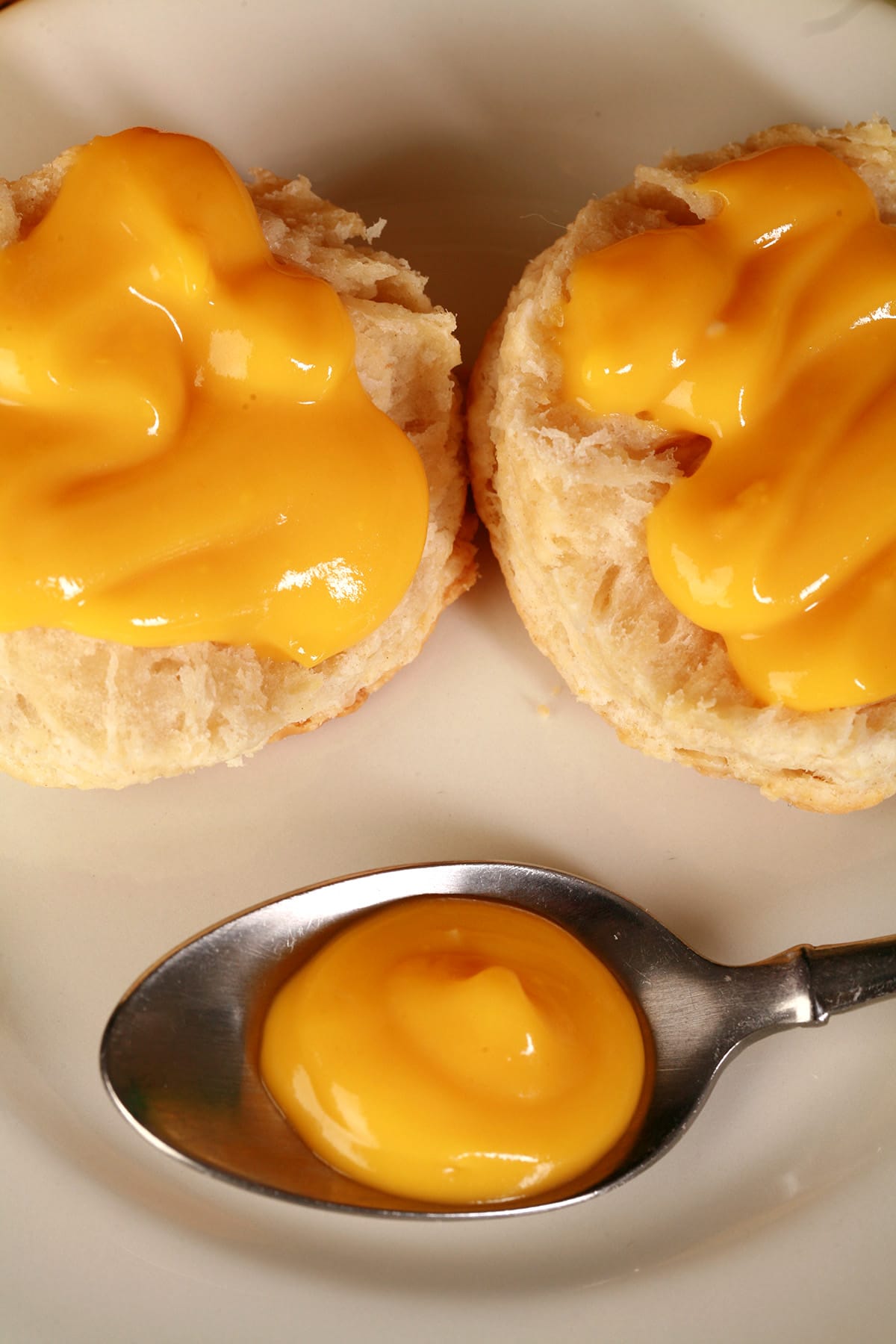
Uses for Mango Curd
Beyond a “just eat it with a spoon, straight from the jar”, there are many, many different uses for mango curd!
Here are a few ideas for you:
- On the breakfast table. Spread some creamy curd on toast, Biscuits, scones, etc. Spoon it over waffles or pancakes (especially good when topped with berries!)
- As a filling for baked goods. Fill Macarons, Cream Puffs or Profiteroles, or layered cakes* with mango curd. This used to be a really popular cake filling option back when I was still making wedding cakes.
- For a mango curd tart, spoon the warm curd into pre-baked tart shells. Let it chill for a few hours, then top with a your favourite mixture of fruit and/or berries. I love the combination of fresh berries with that bold mango flavor from the curd.
- Mango curd is also a great option for Butterfly Cupcakes, either instead of or in addition to frosting. When “in addition to”, I’ll spoon some curd in the cavity, then pipe frosting over it.
- Spoon it over ice cream, Cheesecake, or crepes.
- We like to drizzle it over yogurt that’s been topped with my Porter’s Yogurt and Ice Cream Topping.
- You can also make layered parfaits with curd and yogurt, or curd and cottage cheese.
* When filling layered cakes with curd, it’s best to pipe a ring of frosting around the outer perimeter of the layer being filled, then fill the inside of that border with the curd.
This gives some stability to the filling layer, and will prevent the curd from oozing out.
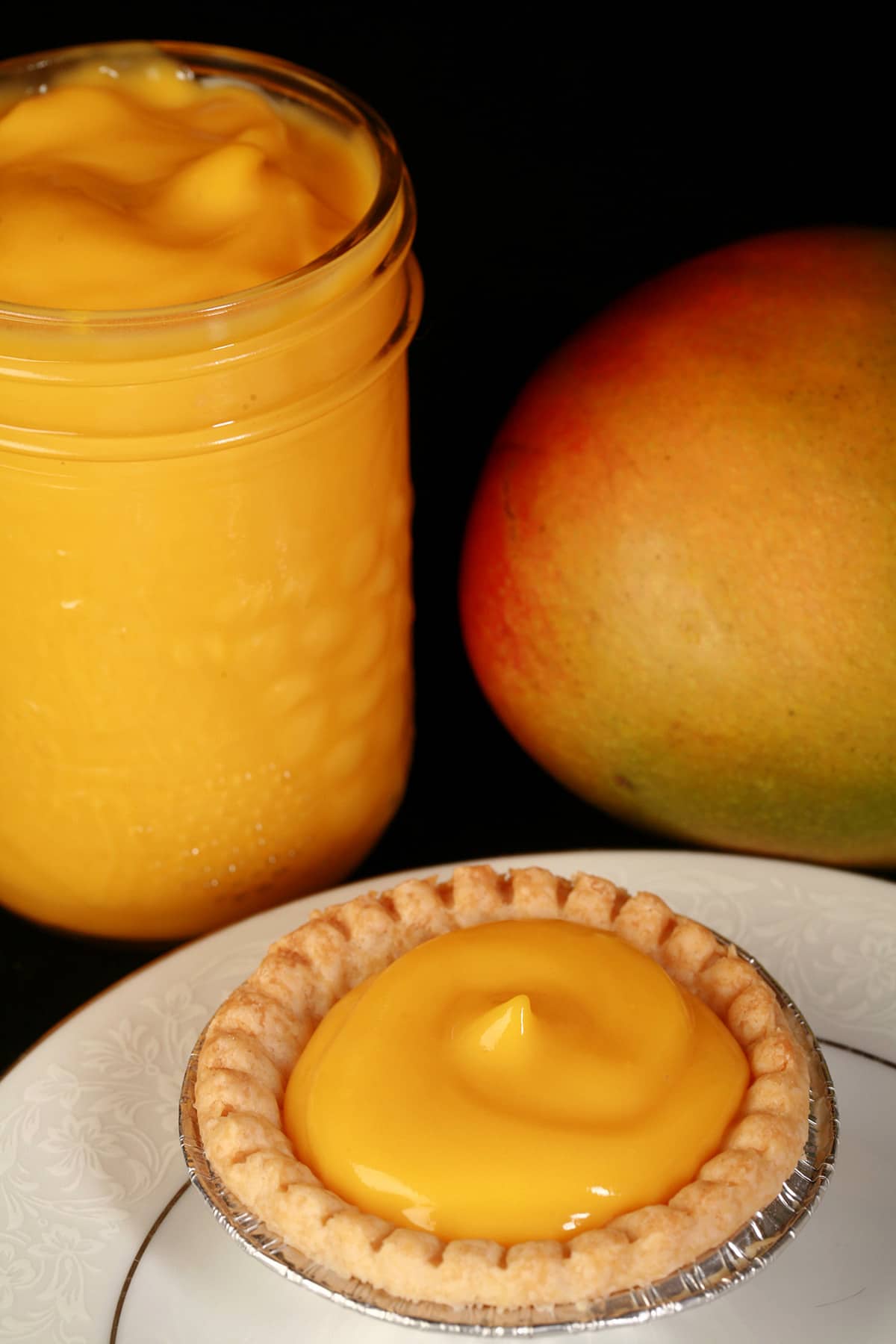
Tips for Making Mango Curd
Mango Curd Ingredients
Most of the ingredients are super simple, and easily found in any larger grocery store: mango purée, sugar, eggs, and unsalted butter.
Canned Mango Pulp
While I usually use fresh fruit for making curds, I actually find that the best flavour comes from canned mango puree.
When using mangos for anything sweet, you really want to use ripe mangoes - which can be hard to come by.
Also, it can be difficult to pick out ripe mangos from unripe or overripe mangoes at times, and then you have to be sure you’re ready to cook with them in the short window of “perfect”.
So, I use canned Mango Pulp for this recipe. It’s a combination of mango, sugar, and citric acid.
It’s a favourite ingredient of mine - usually found in the international section at grocery stores, or at any Indian grocer. It tends to provide an even better fresh mango flavour than fresh mangoes!
It’s a quick and easy way to get a TON of mango flavour, without the hassle of dealing with fresh tropical fruit. And hey, no need for a fine-mesh sieve or food processor!
In this case, it also ensures a very smooth final product. Smooth as Cheez Whiz, LOL!
When I was living in the USA, Swad Kesar Sweetened Mango Pulp was our default, as it was readily available in our local grocer’s international foods aisle for about $3/ can.
Now that we’ve moved back to Canada, the brand that we see more often locally - Quality Alphono Mango Pulp - is the one we tend to default to.
Both taste great and work well, so go with what you have access to - there are plenty of brands out there, I’m sure they’re all great. It’s mango and sugar, after all!
The Other Ingredients
Use basic white granulated sugar for the best taste.
Also, for the best results, use nice fresh eggs.
I use MOSTLY use egg yolks, rather than whole eggs - I find the texture better with just the yolks. I also find that this prevents the curd from having an eggy flavor.
As far as the leftover egg whites go, I like to use them to make Swiss Meringue Buttercream, Meringue Cookies or Pavlova.
Citric acid.
We initially started buying citric acid for use with our Homebrewed Ciders and Wines (along with Acid Blend), but over the years, we've been using it a lot more in our kitchen.
You can find it used in such things like my replica Beep Drink, as part of the fun rim on my Fuzzy Peach Candy Cocktail, and as part of my Wine Slush Mix - always a favourite for gifting!
Citric acid is the “secret” ingredient to providing enough acid for the curd to set up, without diluting the flavour of the curd.
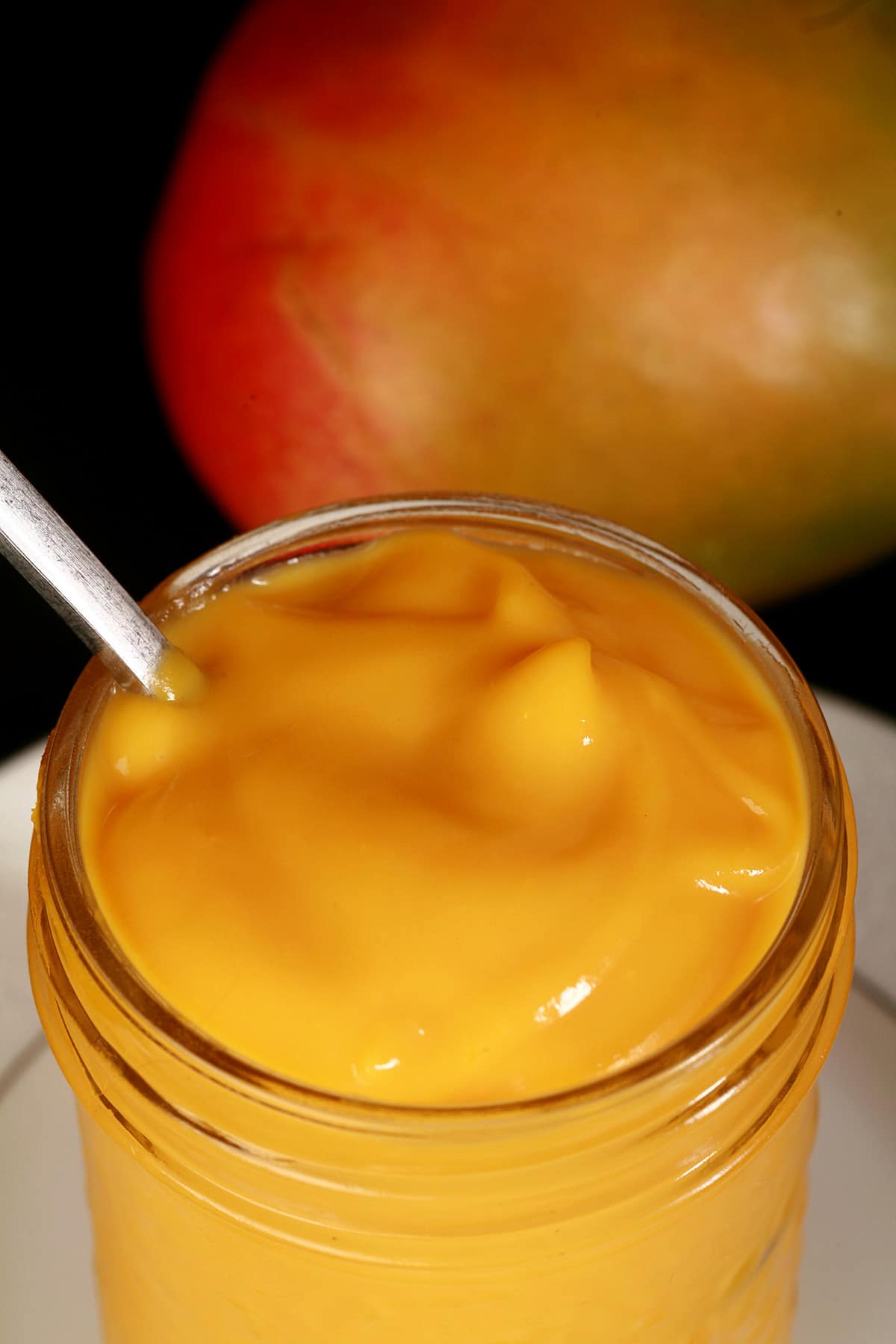
Mango Curd Equipment
You don’t need a ton of equipment to make curd, but each piece you do need is important. Here’s the rundown:
Heavy Bottomed Pot OR Double Boiler
Personally, I prefer using a heavy bottomed pot, but a double boiler is the traditional way to do this... more on that in a bit!
A Silicone Whisk
Yes, wire whisks are great in general... but they can react with the acid in your mango curd, and give the curd a metallic taste.
I like to avoid that whole thing, and just use a silicone whisk. (Stainless steel tends to be ok, though).
Note: it’s a good idea to use a non-reactive saucepan and a nonreactive bowl , for the same reason. “Reactive metal” = prone to acid issues.
When making curd, I use the smallest whisk in my Set of 3 Silicone Whisks.
I just find that the smaller one is best to keep everything moving, and prevent clumps.
That said, any brand of silicone whisk should do just fine.
A Thermometer
For both proper thickening AND food safety reasons, I like to use a thermometer when making fruit curds.
Ensuring that the curd reaches the right temperature is key to having the perfect consistency!
You can use any thermometer that will accurately read a temperature of 165 F.
Personally, I like to use a Infrared Cooking Thermometer. It's quick, easy, and no-mess!

Cooking Technique
While you’re “supposed” to cook this over a double boiler - and I did in the photos - I’ll be honest... I never do.
Every since the first time I made a lemon curd - that took FAR too much time, over a double boiler at a gentle simmer - I like to cook mango curd over lowish, direct heat. I whisk it constantly, and it’s ready in just minutes - so much less fussy.
If you’re not cooking it over higher heat and you keep an eye on it / keep whisking, you’re not going to end up with clumps.
I like to use a heavy bottomed pot, for the best heat distribution.
You’ll find that when you start out, there will be a lot of foaming.
As you approach the right temperature, that foaming will subside - that’s when you should really start keeping an eye on the temperature, to avoid overcooking it.
Finally, just know that the curd will thicken more as it cools, so don’t be so worried if it’s not as thick as you’d like.
If you followed the recipe, did the spoon trick (more on that later), and your curd reached 165F, it’ll thicken!

How Long Does Mango Curd Last?
Depending on who you ask, homemade mango curd will last up to a month or two in the fridge. (ALWAYS refrigerate your curd, it’s not safe to be stored at room temperature!)
Personally, I find it’s best to use it up within 2 weeks, for the best flavour.
I like to keep it in an airtight container - usually a glass jar - with a piece of plastic wrap right against the surface of the mango curd. This prevents a skin from forming.
Can I Freeze Mango Curd?
Yes! It’ll keep for about 6 months in the freezer, and you can freeze it right in a canning jar.
Freeze your curd as fresh as possible - ie, don’t wait til it’s about to go bad.
When you want to use it, let it defrost in the fridge for a day or two before use.
Once the mango curd is thawed, you’ll want to use it within a week or two.

How to Make Mango Curd
The full recipe follows - in the recipe card at the end of this post - but let's start with the pictorial overview!
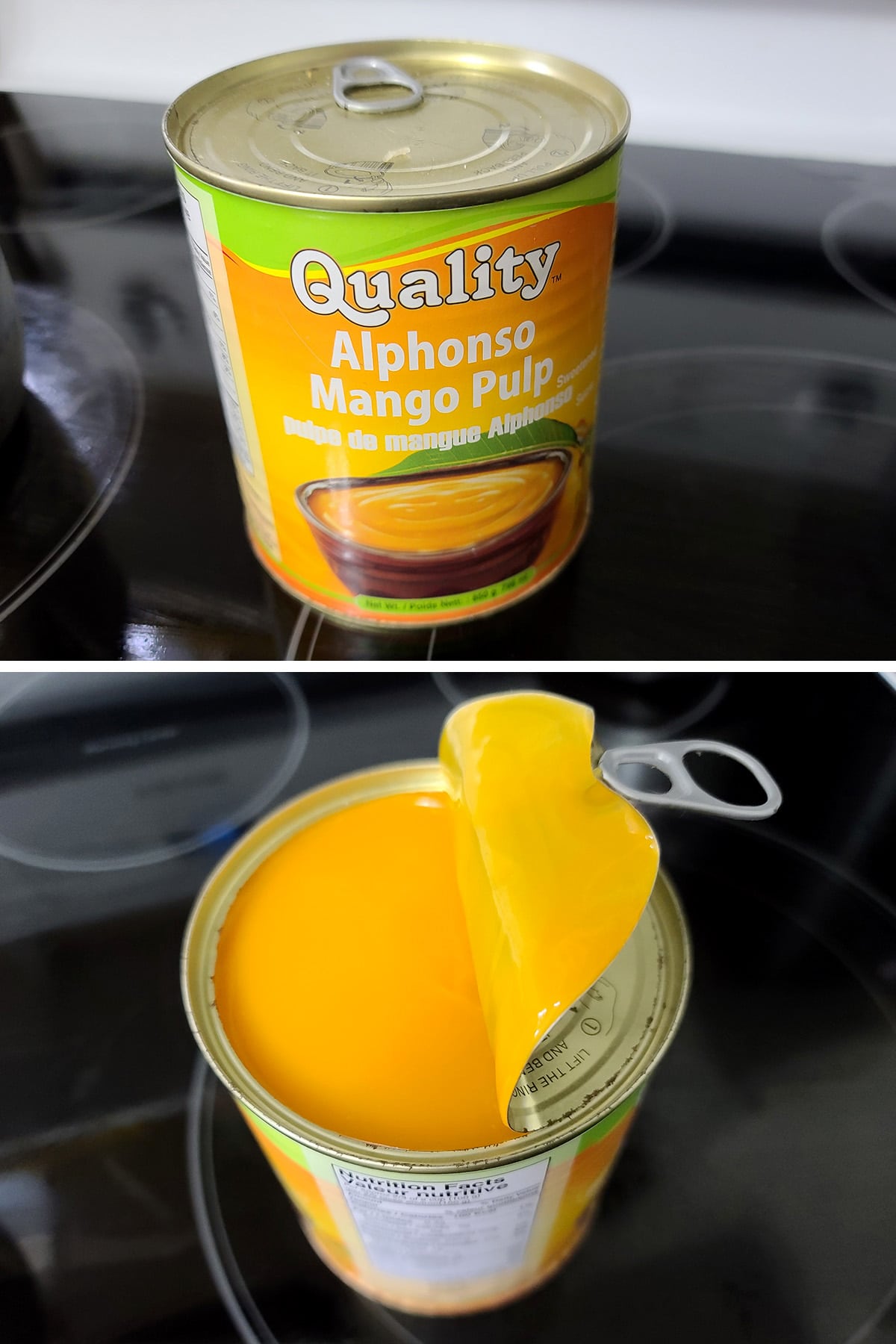
Add the mango puree and the citric acid, whisk until well combined.
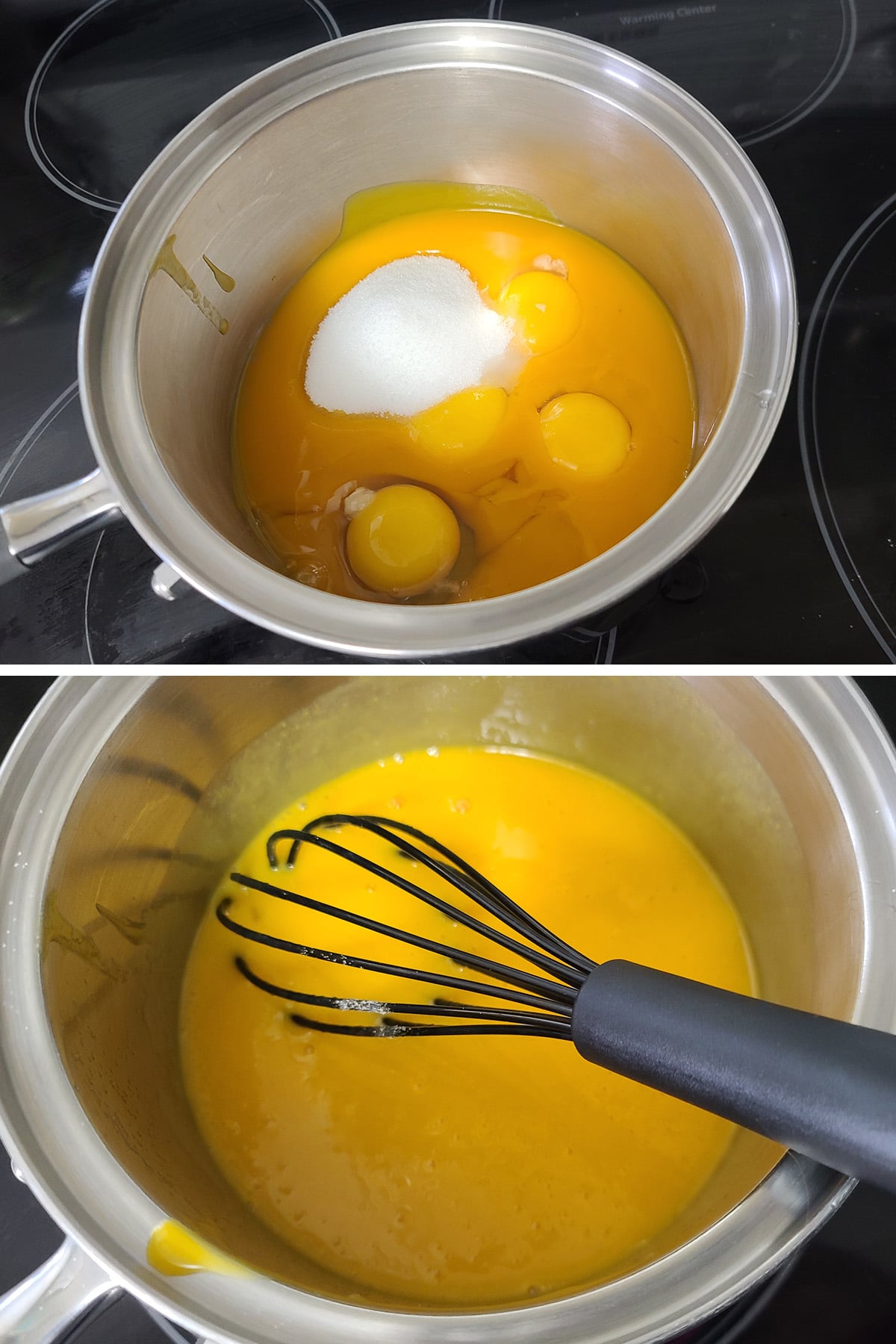
Cook over medium-low heat (medium heat if you’re brave!), whisking constantly, until mixture thickens.
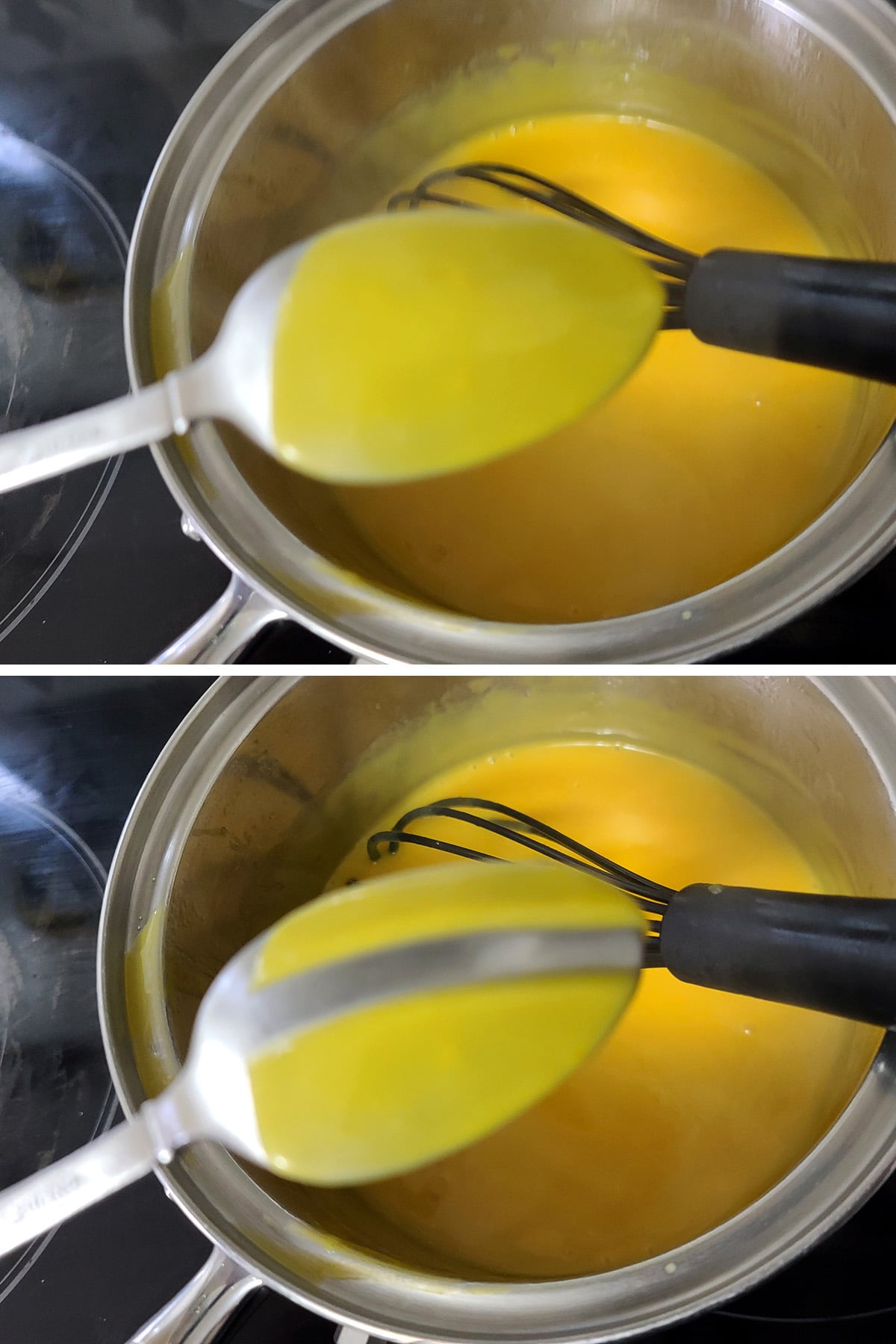
Ideally, you want the mixture to reach 165F - I use an infrared surface thermometer for this.
Once the mixture is thick/hot enough, transfer to a medium bowl (a heat safe bowl!).
Add the pieces of cold butter, whisking until well incorporated.
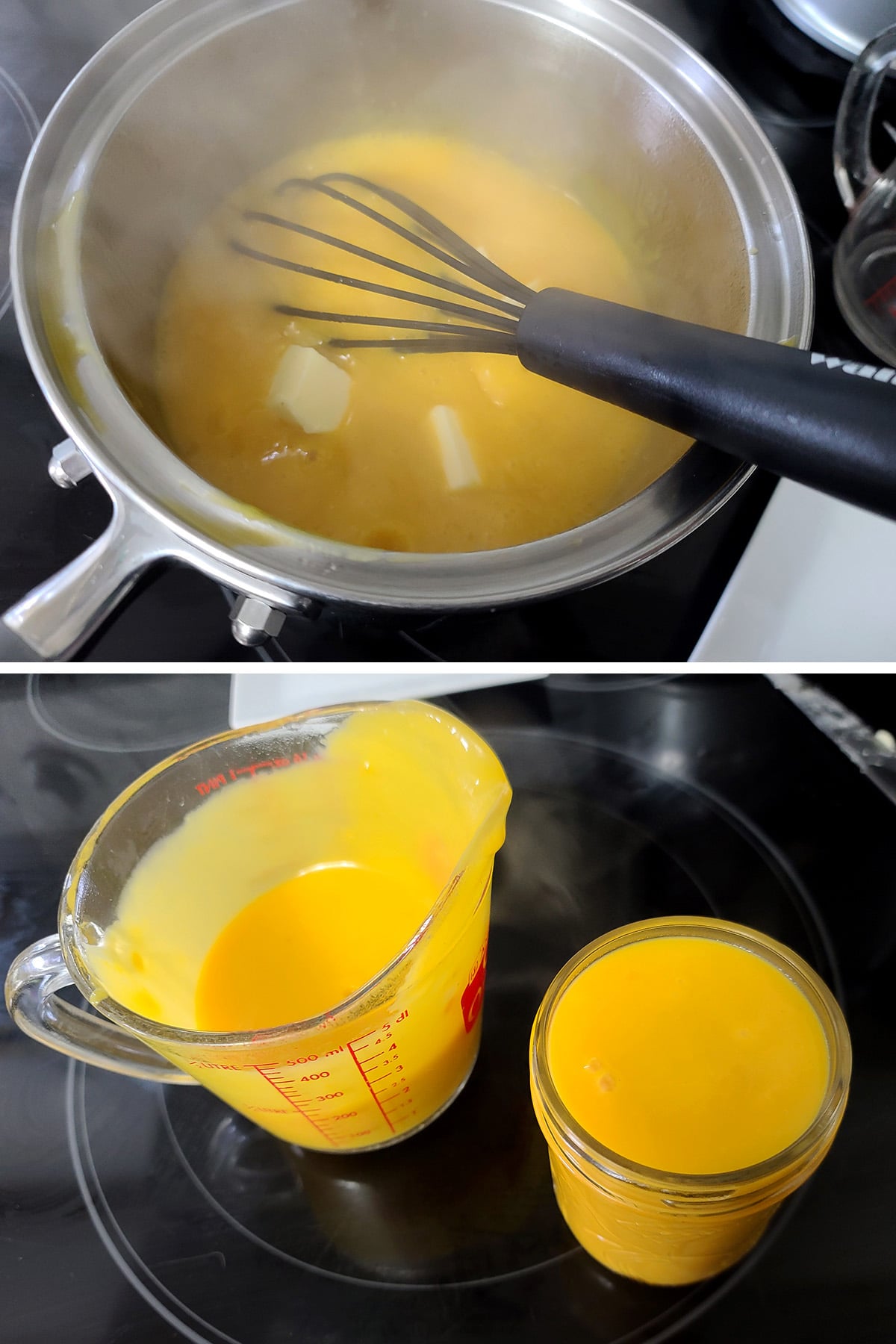
Once all of the butter has melted in and been fully incorporated into the curd, transfer mango curd to your storage container and chill for at least 1 hour before use.

More Fruit Curd Recipes
Looking for more fun fruit curd recipes to dress up your breakfasts, brunches, or desserts? I've got you covered!
Blackcurrant Curd
Blueberry Curd
Cranberry Curd
Grape Curd
Grapefruit Curd
Kiwi Curd
Lemon Curd
Lime Curd
Orange Curd
Passionfruit Curd
Raspberry Curd
Sugar Free Lemon Curd

Share the Love!
Before you chow down, be sure to take some pics of your handiwork! If you post it to Bluesky, be sure to tag us - @CelebrationGen. We're also on Pinterest, so you can save all your favourite recipes to a board!
Also, be sure to subscribe to my free monthly email newsletter, so you never miss out on any of my nonsense. Well, the published nonsense, anyway!
Finally, if you love this recipe, please consider leaving a star rating and/or a comment below, and maybe even sharing this post on social media!

Easy Mango Curd
Equipment
- Silicone Whisk
- Infrared Surface Thermometer
Ingredients
- ¼ cup Granulated Sugar
- 3 Large Egg Yolks
- 1 Large Egg
- 1 cup Mango Pulp
- 1 teaspoon Citric Acid
- 6 tablespoon Salted Butter Chilled and cut into pieces.
Instructions
- In a small pot, whisk together egg yolks, large egg, and sugar until well combined. Add the mango pulp and the citric acid, whisk until well combined.
- Cook over medium heat, whisking constantly, until mixture thickens. It should be able to coat the back of a spoon and retain a clear trail when a finger is dragged across the back of the spoon. Ideally, you want the mixture to reach 165F - I use an infrared surface thermometer for this.
- Once mixture is thick / hot enough, transfer to a bowl. Add the pieces of butter, whisking until well incorporated.
- Once all of the butter has melted in and been fully incorporated into the curd, transfer mango curd to your storage container and chill for at least 1 hour before use.
Notes
Nutrition





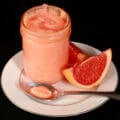

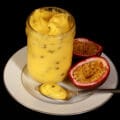
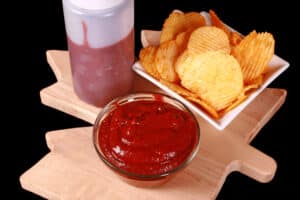



Rosalind Savage
Can you use fresh alphonso Mangoes. If so, how? Thank you.
Marie Porter
I would imagine so, but you'd want a really smooth puree, and you'd have to add sugar.
Adam Shapiro
Made it to fill a birthday cake. Loved the texture. The consistency was beautiful. HOWEVER, I think this recipe calls for way too much butter. The beautiful mango flavor was muddled significantly after I added the butter. Yes, it helps emulsify the product, but then all I tasted was the fat from the butter. Even after it was chilled, the butter really overpowered the brightness of the mango. If I make this again, I would use no more than two or three tablespoons.
Vanessa
I used this recipe to make a starfruit curd, and it was absolutely delicious! I’ve used several of your recipes, and I love them all! My only question is, is there a way to make a thicker curd so that it can be piped? I like to use these as fillings for Macarons, but I would love to be able to do it without having to put up a buttercream barrier.
missy
I had 6 small yolks leftover from macaroons so I just used those perfect! I also subbed 1 tablespoon of coconut oil for butter. Used this curd as part of my mango macaroon filling TY
al
great trick to use citric acid. but in the end I thought it was a bit too acid. Have yo tried with less? or compensate with more sugar? the end product is still pretty fluid, a slightly thicker version would be nice! cheers